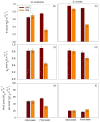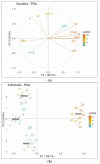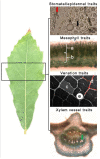The Leaf Trichome, Venation, and Mesophyll Structural Traits Play Important Roles in the Physiological Responses of Oak Seedlings to Water-Deficit Stress
- PMID: 35955770
- PMCID: PMC9369340
- DOI: 10.3390/ijms23158640
The Leaf Trichome, Venation, and Mesophyll Structural Traits Play Important Roles in the Physiological Responses of Oak Seedlings to Water-Deficit Stress
Abstract
In this study, we investigated the effects of water-deficit stress on the leaf anatomical traits, physiological traits, and stem starch content in Quercus acutissima Carruth and Quercus serrata Murray by subjecting their seedlings to well-watered (WW) and water-deficit stress (WS) treatments. The water stress-induced changes in trichome density, trichome-to-stomata ratio, mesophyll thickness, vein density, vein distance, vein loopiness, vessel diameter, transpiration (E), stomatal conductance (gs), water use efficiency (WUE), and starch content were analyzed between two time points. While trichome density did not vary between treatments in Q. acutissima, it dramatically increased in Q. serrata (62.63-98.96 trichomes mm-2) at the final week. The WS-treated seedlings had a thicker palisade mesophyll (162.85-169.56 µm) than the WW-treated samples (118.56-132.25 µm) in both species. The vein density and loopiness increased significantly in the WS-treated Q. serrata seedlings. Small-sized vessels (10-50 µm) were more frequent in the WS than the WW in Q. serrata. The E, gs, WUE, and starch content declined significantly in the WS-treated seedlings compared with WW-treated samples in both species. Further, principal component analysis revealed significant relationships between anatomical and physiological traits, particularly in the WS-treated seedlings of Q. serrata. The coordinated changes in leaf anatomical traits, physiological traits, and stem starch content indicate an important role in the survival of Q. acutissima and Q. serrata seedlings in water-deficit stress environments, although Q. serrata may show higher survivability under prolonged water stress than Q. acutissima.
Keywords: drought stress; drought tolerance; oak species; starch reserves; stomatal conductance; water use efficiency.
Conflict of interest statement
The authors declare no conflict of interest.
Figures











Similar articles
-
Morpho-Anatomical Traits and Soluble Sugar Concentration Largely Explain the Responses of Three Deciduous Tree Species to Progressive Water Stress.Front Plant Sci. 2021 Dec 7;12:738301. doi: 10.3389/fpls.2021.738301. eCollection 2021. Front Plant Sci. 2021. PMID: 34950160 Free PMC article.
-
Physiological responses of Quercus acutissima and Quercus rubra seedlings to drought and defoliation treatments.Tree Physiol. 2023 May 12;43(5):737-750. doi: 10.1093/treephys/tpad005. Tree Physiol. 2023. PMID: 36708029
-
Coordination of leaf hydraulic, anatomical, and economical traits in tomato seedlings acclimation to long-term drought.BMC Plant Biol. 2021 Nov 15;21(1):536. doi: 10.1186/s12870-021-03304-y. BMC Plant Biol. 2021. PMID: 34781896 Free PMC article.
-
Cavitation, stomatal conductance, and leaf dieback in seedlings of two co-occurring Mediterranean shrubs during an intense drought.J Exp Bot. 2003 Sep;54(390):2015-24. doi: 10.1093/jxb/erg221. Epub 2003 Jul 28. J Exp Bot. 2003. PMID: 12885857 Review.
-
Leaf physiological and morphological constraints of water-use efficiency in C3 plants.AoB Plants. 2023 Jul 31;15(4):plad047. doi: 10.1093/aobpla/plad047. eCollection 2023 Jul. AoB Plants. 2023. PMID: 37560762 Free PMC article. Review.
Cited by
-
Sunflower Leaf Structure Affects Chlorophyll a Fluorescence Induction Kinetics In Vivo.Int J Mol Sci. 2022 Nov 30;23(23):14996. doi: 10.3390/ijms232314996. Int J Mol Sci. 2022. PMID: 36499324 Free PMC article.
-
Environmental Stress and Plants 2.0.Int J Mol Sci. 2023 Aug 4;24(15):12413. doi: 10.3390/ijms241512413. Int J Mol Sci. 2023. PMID: 37569788 Free PMC article.
-
Leaf morpho-physiological traits of Populus sibirica and Ulmus pumila in different irrigation regimes and fertilizer types.PeerJ. 2023 Sep 29;11:e16107. doi: 10.7717/peerj.16107. eCollection 2023. PeerJ. 2023. PMID: 37790615 Free PMC article.
-
Melatonin imparts tolerance to combined drought and high-temperature stresses in tomato through osmotic adjustment and ABA accumulation.Front Plant Sci. 2024 Mar 28;15:1382914. doi: 10.3389/fpls.2024.1382914. eCollection 2024. Front Plant Sci. 2024. PMID: 38606062 Free PMC article.
-
Regulatory mechanisms of trichome and root hair development in Arabidopsis.Plant Mol Biol. 2024 Dec 30;115(1):14. doi: 10.1007/s11103-024-01534-w. Plant Mol Biol. 2024. PMID: 39739145 Review.
References
-
- United Nations Convention to Combat Desertification [UNCCD] [(accessed on 2 May 2022)]. Available online: https://www.unccd.int/news-stories/stories/latest-climate-report-undersc....
-
- Méndez-Toribio M., Ibarra-Manríquez G., Paz H., Lebrija-Trejos E. Atmospheric and soil drought risks combined shape community assembly of trees in a tropical dry forest. J. Ecol. 2020;108:1347–1357. doi: 10.1111/1365-2745.13355. - DOI
-
- Resende A.F., Piedade M.T.F., Feitosa Y.O., Andrade V.H.F., Trumbore S.E., Durgante F.M., Macedo M.O., Schöngart J. Flood-pulse disturbances as a threat for long-living Amazonian trees. New Phytol. 2020;227:1790–1803. - PubMed
-
- Han J., Singh V.P. Forecasting of droughts and tree mortality under global warming: A review of causative mechanisms and modeling methods. J. Water Clim. Chang. 2020;11:600–632.
-
- Dai A. Drought under global warming: A Review. WIREs Clim. Chang. 2020;2:45–65. doi: 10.1002/wcc.81. - DOI
MeSH terms
Substances
Grants and funding
LinkOut - more resources
Full Text Sources

